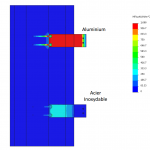Structural thermal bridges are definitely not to be ignored.
We were consulted on a project in Lyon, not as a manufacturer but for the calculation of thermal bridges related to fixings.
The system used for this project is a double aluminium rail system, with aluminium brackets as fixings, as shown in the image below

The target building is a pilot project. Indeed, the thermal engineering office in charge of the project is responsible, among other things, for the real future consumption of the building and does not limit itself to the theoretical pre-study. In this case, the design office requires that the Up value specified in the project specifications be respected, with Up=0.17 W/(m².K), taking into account the structural thermal bridges linked to the fixing brackets.
We were asked to calculate thermal bridge of the aluminium bracket.
The result is a PTI value of X(chi) of : X(alu) = 0.0460 W/K
With this material, the target value of 0.17 W/(m².K) could not be achieved. We therefore recommended a solution with stainless steel mounting brackets as an alternative.
The X(chi) value of the PTI is : X(stainlesssteel) = 0.0092 W/K, which is 5 times lower than the first value!
The X(chi) value of the PTI is : X(inox) = 0.0092 W/K, which is 5 times lower than the first value!
To better understand this difference with an illustration, below you can find a thermal calculation with the two different materials, the two brackets are the same, the environment is the same, the pegs are the same (stainless steel).
The parts can be seen in their environment (succession of layers of plaster, insulation, concrete), and the thermal flux (heat) coming out of the two fasteners can be observed. Except that for the aluminium, the value is at saturation (red colour) in the chosen scale, while this heat flow is much lower for the similar stainless steel fastener.
We recommend the calculation of thermal bridges and their inclusion in the calculations as a solution to many thermal problems (e.g. actual building consumption >> theoretical consumption).
The use of stainless steel in cladding frames is therefore highly recommended.
Illustration of the final product:

















Leave a Comment
You must be logged in to post a comment.